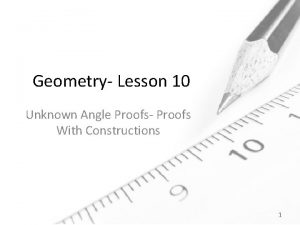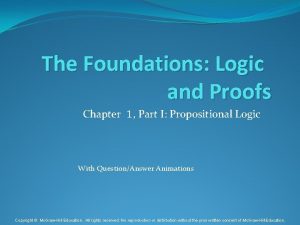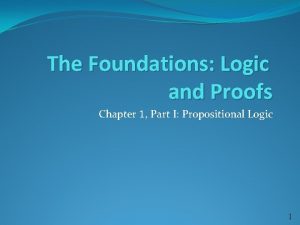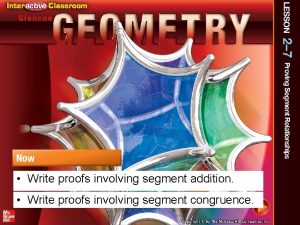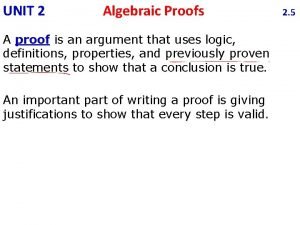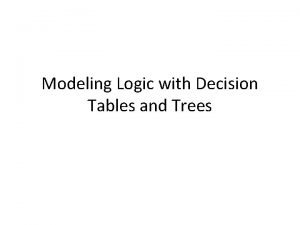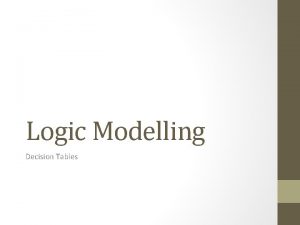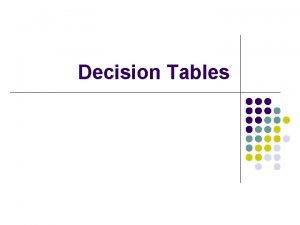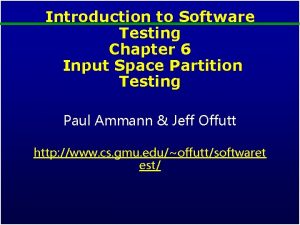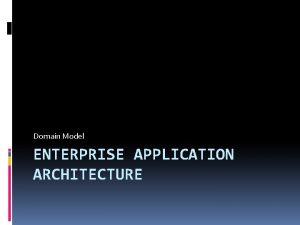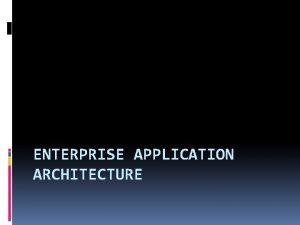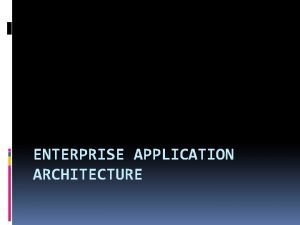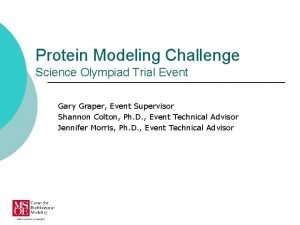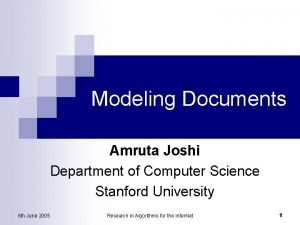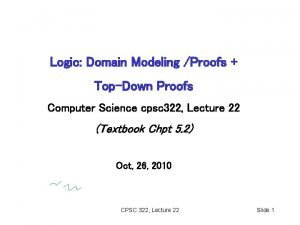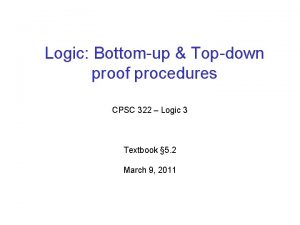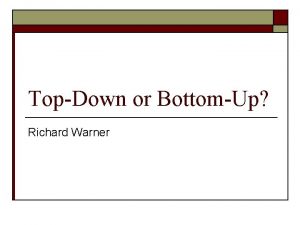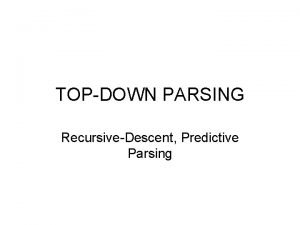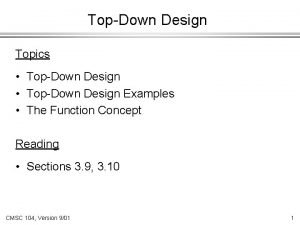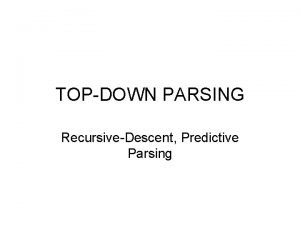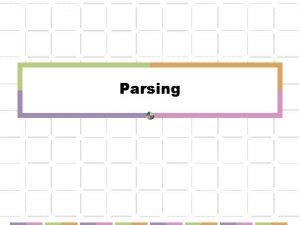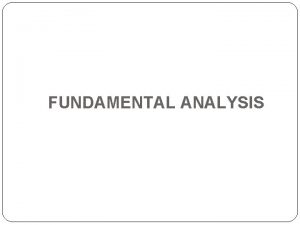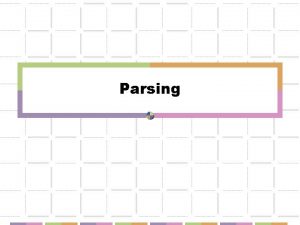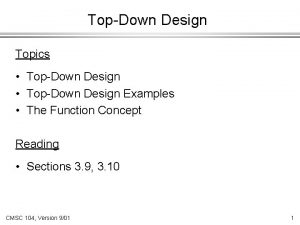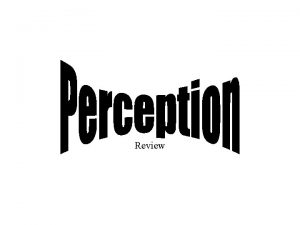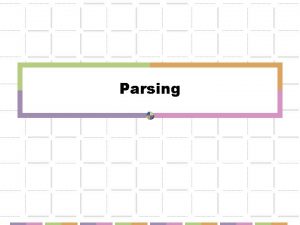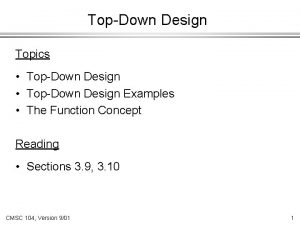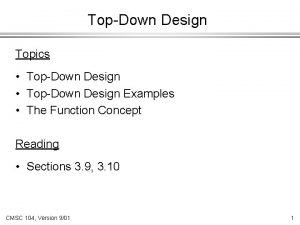Logic Domain Modeling Proofs TopDown Proofs Computer Science



























- Slides: 27

Logic: Domain Modeling /Proofs + Top-Down Proofs Computer Science cpsc 322, Lecture 22 (Textbook Chpt 5. 2) June, 8, 2017 CPSC 322, Lecture 22 Slide 1

Lecture Overview • Recap • Using Logic to Model a Domain (Electrical System) • Reasoning/Proofs (in the Electrical Domain) • Top-Down Proof Procedure CPSC 322, Lecture 21 Slide 2

Soundness & completeness of procedures • A proof procedure X is sound … • A proof procedure X is complete…. • Bottom. Up for PDCL is • We proved this in general even for domains represented by thousands of propositions and corresponding KB with millions of definite clauses ! CPSC 322, Lecture 21 Slide 3

Lecture Overview • Recap • Using PDCL Logic to Model a Domain (Electrical System) • Reasoning/Proofs (in the Electrical Domain) • Top-Down Proof Procedure CPSC 322, Lecture 21 Slide 4

Electrical Environment /down / up CPSC 322, Lecture 21 Slide 5

Let’s define relevant propositions /down / up How many interpretations? • • • For For For each each wire w circuit breaker cb switch s light l outlet p CPSC 322, Lecture 21 • • • 7 2 3 x 2 2 2 Slide 6

Let’s now tell system knowledge about how the domain works /down / up live_l 1 ← live_w 0 ← live_w 1 ← CPSC 322, Lecture 21 Slide 7

More on how the domain works…. /down / up live_w 2 ← live_w 3 ∧ down_s 1. live_l 2 ← live_w 4 ← live_w 3 ∧ up_s 3. live_p 1 ← live_w 3. CPSC 322, Lecture 21. Slide 8

More on how the domain works…. /down / up live_w 3 live_p 2 live_w 6 live_w 5 ← ← live_w 5 ∧ ok_cb 1. live_w 6. live_w 5 ∧ ok_cb 2. live_outside. CPSC 322, Lecture 21 Slide 9

What else we may know about this domain? • That some simple propositions are true live_outside. /down / up CPSC 322, Lecture 21 Slide 10

What else we may know about this domain? • That some additional simple propositions are true down_s 1. up_s 2. up_s 3. ok_cb 1. ok_cb 2. live_outside. /down / up CPSC 322, Lecture 21 Slide 11

All our knowledge…. . down_s 1. up_s 2. up_s 3. ok_cb 1. ok_cb 2. live_outside live_l 1 ← live_w 0 ← live_w 1 ∧ up_s 2. live_w 0 ← live_w 2 ∧ down_s 2. live_w 1 ← live_w 3 ∧ up_s 1. live_w 2 ← live_w 3 ∧ down_s 1. live_l 2 ← live_w 4 ← live_w 3 ∧ up_s 3. live_p 1 ← live_w 3. /down live_w 3 ← live_w 5 ∧ ok_cb 1. live_p 2 ←/ up live_w 6 ← live_w 5 ∧ ok_cb 2. live_w 5 ← live_outside. CPSC 322, Lecture 21 Slide 12

Lecture Overview • Recap • Using Logic to Model a Domain (Electrical System) • Reasoning/Proofs (in the Electrical Domain) • Top-Down Proof Procedure CPSC 322, Lecture 21 Slide 13

What Semantics is telling us • Our KB (all we know about this domain) is going to be true only in a subset of all possible _____interpretations • What is logically entailed by our KB are all the propositions that are true in all those interpretations • This is what we should be able to derive given a sound and complete proof procedure CPSC 322, Lecture 21 Slide 14

If we apply the bottom-up (BU) proof procedure down_s 1. up_s 2. up_s 3. ok_cb 1. ok_cb 2. live_outside live_l 1 ← live_w 0 ← live_w 1 ∧ up_s 2. live_w 0 ← live_w 2 ∧ down_s 2. live_w 1 ← live_w 3 ∧ up_s 1. live_w 2 ← live_w 3 ∧ down_s 1. live_l 2 ← live_w 4 ← live_w 3 ∧ up_s 3. live_p 1 ← live_w 3. . live_w 3 ← live_w 5 ∧ ok_cb 1. live_p 2 ← live_w 6 ← live_w 5 ∧ ok_cb 2. live_w 5 ← live_outside. CPSC 322, Lecture 21 Slide 15

Lecture Overview • Recap • Using Logic to Model a Domain (Electrical System) • Reasoning/Proofs (in the Electrical Domain) • Top-Down Proof Procedure CPSC 322, Lecture 21 Slide 16

Bottom-up vs. Top-down Bottom-up KB C G is proved if G C When does BU look at the query G ? A. In every loop iteration C. Only at the end B. Never D. Only at the beginning

Bottom-up vs. Top-down • Key Idea of top-down: search backward from a query G to determine if it can be derived from KB. Top-down Bottom-up KB C G is proved if G C When does BU look at the query G? • At the end Query G KB answer TD performs a backward search starting at G

Top-down Ground Proof Procedure Key Idea: search backward from a query G to determine if it can be derived from KB. CPSC 322, Lecture 22 Slide 19

Top-down Proof Procedure: Basic elements Notation: An answer clause is of the form: yes ← a 1 ∧ a 2 ∧ … ∧ am Express query as an answer clause (e. g. , query a 1 ∧ a 2 ∧ … ∧ am ) yes ← Rule of inference (called SLD Resolution) Given an answer clause of the form: yes ← a 1 ∧ a 2 ∧ … ∧ am and the clause: ai ← b 1 ∧ b 2 ∧ … ∧ b p You can generate the answer clause yes ← a 1 ∧ … ∧ ai-1 ∧ b 2 ∧ … ∧ bp ∧ ai+1 ∧ … ∧ am CPSC 322, Lecture 22 Slide 20

Rule of inference: Examples Rule of inference (called SLD Resolution) Given an answer clause of the form: yes ← a 1 ∧ a 2 ∧ … ∧ am and the KB clause: ai ← b 1 ∧ b 2 ∧ … ∧ b p You can generate the answer clause yes ← a 1 ∧ … ∧ ai-1 ∧ b 2 ∧ … ∧ bp ∧ ai+1 ∧ … ∧ am yes ← b ∧ c. b ← k ∧ f. yes ← e ∧ f. e. CPSC 322, Lecture 22 Slide 21

(successful) Derivations • An answer is an answer clause with m = 0. That is, it is the answer clause yes ←. • A (successful) derivation of query “? q 1 ∧ … ∧ qk “ from KB is a sequence of answer clauses γ 0 , γ 1 , …, γn such that • γ 0 is the answer clause yes ← q 1 ∧ … ∧ qk • γi is obtained by resolving γi-1 with a clause in KB, and • γn is an answer. • An unsuccessful derivation…. . CPSC 322, Lecture 22 Slide 22

Example: derivations a ← e ∧ f. c ← e. f ← j ∧ e. a ← b ∧ c. d ← k. f ← c. b ← k ∧ f. e. j ← c. Query: a (two ways) yes ← a. CPSC 322, Lecture 22 Slide 23

Example: derivations k ← e. c ← e. f ← j ∧ e. a ← b ∧ c. d ← k. f ← c. b ← k ∧ f. e. j ← c. Query: b ∧ e A. Provable by TD B. It depends C. Not Provable by TD CPSC 322, Lecture 22 Slide 24

Course Big Picture Environment Problem Static Deterministic Arc Consistency Search Constraint Vars + Satisfaction Constraints Stochastic SLS Belief Nets Inference Logics Search Sequential Planning Representation Reasoning Technique STRIPS Search Var. Elimination Decision Nets Var. Elimination Markov Processes Value Iteration CPSC 322, Lecture 2 Slide 25

Standard Search vs. Specific R&R systems Constraint Satisfaction (Problems): • State: assignments of values to a subset of the variables • Successor function: assign values to a “free” variable • Goal test: set of constraints • Solution: possible world that satisfies the constraints • Heuristic function: none (all solutions at the same distance from start) Planning : • State possible world • Successor function states resulting from valid actions • Goal test assignment to subset of vars • Solution sequence of actions • Heuristic function empty-delete-list (solve simplified problem) Logical Inference • State answer clause • Successor function states resulting from substituting one • • • atom with all the clauses of which it is the head Goal test empty answer clause Solution start state Heuristic function …. . (next time) CPSC 322, Lecture 11 Slide 26

Learning Goals for today’s class You can: • Model a relatively simple domain with propositional definite clause logic (PDCL) • Trace query derivation using SLD resolution rule of inference CPSC 322, Lecture 4 Slide 27
 Top down processing example
Top down processing example Lesson 10 unknown angle proofs
Lesson 10 unknown angle proofs Lesson 9 unknown angle proofs—writing proofs
Lesson 9 unknown angle proofs—writing proofs Modeling and role modeling theory
Modeling and role modeling theory Dimensional modeling vs relational modeling
Dimensional modeling vs relational modeling Equivalent disjunctive form example
Equivalent disjunctive form example The foundations logic and proofs
The foundations logic and proofs Segment proofs
Segment proofs Unit 2 logic and proof homework 1
Unit 2 logic and proof homework 1 Modeling logic with decision tables
Modeling logic with decision tables Modeling logic with decision tables
Modeling logic with decision tables Modeling logic with decision tables
Modeling logic with decision tables Input domain modeling
Input domain modeling What's your favourite lesson
What's your favourite lesson First order logic vs propositional logic
First order logic vs propositional logic First order logic vs propositional logic
First order logic vs propositional logic First order logic vs propositional logic
First order logic vs propositional logic Combinational vs sequential logic
Combinational vs sequential logic Cryptarithmetic problem logic+logic=prolog
Cryptarithmetic problem logic+logic=prolog Software development plan
Software development plan Is it x y or y x
Is it x y or y x Combinational logic sequential logic 차이
Combinational logic sequential logic 차이 Combinational logic sequential logic
Combinational logic sequential logic Domain logic patterns
Domain logic patterns Domain logic patterns
Domain logic patterns Domain logic patterns
Domain logic patterns Business modeling olympiad
Business modeling olympiad Science modeling documents
Science modeling documents

